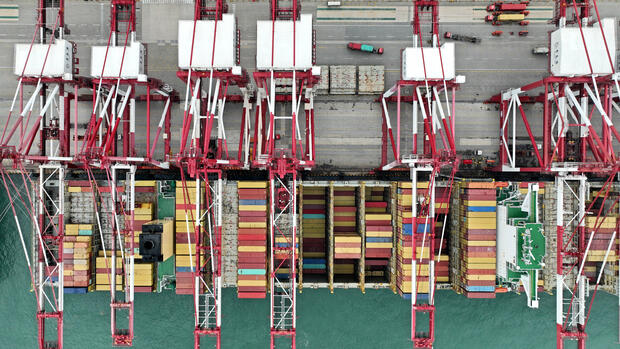According to the government, the Chinese economy has grown strongly.
(Photo: dpa)
Beijing The Chinese economy has surprisingly accelerated its growth after the end of the strict corona policy. The gross domestic product (GDP) increased by 4.5 percent from January to March compared to the same period last year, as the statistics office in Beijing announced on Tuesday. This is the strongest quarterly increase in a year, which is mainly due to rising consumer spending and exports.
Economists surveyed by the Reuters news agency had only expected an increase of 4.0 percent. The second largest economy in the world after the USA had grown by only 2.9 percent in the previous fourth quarter of 2022.
“The economic recovery is on the right track,” commented the chief economist at asset manager Pinpoint Asset Management, Zhiwei Zhang, on the development. “The bright spot is consumption.” With the end of the zero-Covid policy, which included recurring lockdowns of entire metropolises, the Chinese are traveling and shopping more again. The rather disappointing industrial production prevented a better performance, while construction investments actually fell.
Qoq GDP grew 2.2 percent in January-March, in line with analysts’ expectations and ahead of the revised 0.6 percent increase in the previous quarter.
“By and large, the figures from China for the first quarter are quite decent and are in line with the growth target of around five percent this year,” said analyst Matt Simpson of the financial provider City Index. “This lifts the mood in Asia a little.”
Retail sales growth hits two-year high
Separate economic data for March, also released on Tuesday, showed retail sales growth accelerating to 10.6 percent, a two-year high.
Industrial production grew significantly more slowly at 3.9 percent and thus fell short of expectations. This could be due to the fact that consumers in the USA and Europe are saving on goods consumption. “Furniture and electronics are giving way to going to a restaurant or going on vacation,” said the chief economist at VP Bank, Thomas Gitzel. “But electronic devices and furniture in particular come from the Middle Kingdom, which fundamentally put a strain on industrial production.”
The Organization for Economic Cooperation and Development (OECD) believes that the People’s Republic will grow by 5.3 percent this year due to the recovery from the corona pandemic, after an increase of only three percent in 2022. In 2024 there should be a similarly strong increase of 4.9 percent.
After that, many economists expect a slower pace. “The country’s advanced industrialization and demographic change will be reflected in lower growth rates,” said Gitzel. Geopolitical shifts remain another risk. “The USA in particular, but also Europe, are elbowing out China,” said expert Gitzel. “In the past, China benefited disproportionately from these two regions.” His conclusion is therefore: “The Chinese economy will transition from the tango to the waltz”.
China is by far Germany’s most important trading partner. German industry wants to continue expanding trade with the People’s Republic despite warnings from politicians about growing dependency.
“Diversification does not mean decoupling us from China, but reducing and ideally overcoming one-sided dependencies,” said the President of the Federation of German Industries (BDI), Siegfried Russwurm, on Monday at the Hanover Fair. “China is and will remain a key market for German companies.” There is a fairly broad consensus that the German economy needs China. The dependency on critical materials and components is a concern. “It’s not something that can be turned around in a year.”
More: G7 countries are moving closer together – and are sending a clear message to China
